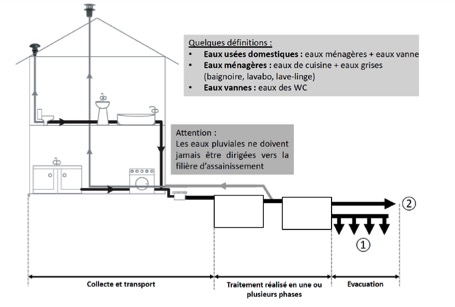The Public Non-Collective Sanitation Service
Since 1 April 2004, as required by the 1992 Water Act, the Community of Communes of Quercy Rouergue and the Aveyron Gorges has been responsible for managing the non-collective sanitation service (SPANC) for all the communes in the area.
The tasks of the SPANC :
The purpose of this service is to carry out inspections of non-collective sanitation installations and provide information to users.
There are 3 types of controls:
- Design inspection for new installations: carried out when a building permit or rehabilitation application is submitted, this consists of checking that the regulations have been complied with and that the project is adaptable to the constraints of the land and the house.
- Inspection - completion of new installations: carried out at the end of the works before backfilling, this allows you to check, on site, that the works installed correspond to the approved project and that the technical rules for installation have been respected.
- Periodic monitoring of the correct operation of all installations: carried out every 10 years, the aim is to ensure that the installation is operating correctly and that the works are being properly maintained. If a malfunction is observed, the technician will recommend the necessary changes.
Fees :
The inspections carried out by SPANC give rise to invoicing and collection of fees from the owner of the installation.
Contact
Dimitri Aurel, SPANC technician Pétampes 82160 Caylus
07 78 49 13 05 - 05 63 65 77 78 - spanc@cc-qrga.fr
Lucas Trenty, SPANC technician Pétampes 82160 Caylus
06 24 20 37 58 - 05 63 65 77 78 - assainissement@cc-qrga.fr
Financial assistance
the zero-rate eco-loan :
Work to rehabilitate non-collective sanitation systems that do not consume energy
can be financed by a zero-rate eco-loan of up to €10,000.
Once you have decided on the type of work you want to carry out, you need to contact a banking institution with the following resources
a standard quotation form completed with the companies selected.
Maintaining your drainage system
A few tips on using and maintaining your wastewater system:
We strongly advise you not to throw anything into your system:
- frying and waste oils and fats ;
- paint, solvents ;
- waxes, resins ;
- petroleum products ;
- all types of pesticides;
- all toxic products (see labelling);
- items that are difficult to break down: cigarette butts, feminine hygiene products, condoms, ashes, household waste, rags, packaging, wipes, etc.
Cleaning products such as bleach, detergents, etc. should be used sparingly. If used excessively, these products will alter the bacteria whose role is to ensure purification by consuming organic matter.
Biological activators :
The use of biological activators is not compulsory but may be recommended:
- in the event of prolonged absence from the home (second home) in order to reactivate the bacterial system inside the tank;
- in the event of prolonged or intensive treatment with antibiotics.
Maintenance of your all-water tank (or septic tank):
The all-water tank must be emptied when the level of sludge reaches 50% (30% for micro-stations) of the useful volume of the tank (cf. decree of 7 September 2009). This sludge level can be measured using a flexible stick dipped into the tank.
This corresponds to an average period of use of 4 years (for a principal residence).
This draining can only be carried out by an approved drainer, a list of which is available here (http://www.assainissement-non-collectif.developpement-durable.gouv.fr/liens-vers-les-listes-de-vidangeurs-agrees-a619.html).
Please note: Always leave a layer of sludge in the pit so that the pit's bacteria can be reactivated immediately when the water is put back in.
Maintenance of the pit prefilter (decolloider) :
Filter materials (pozzolans, filter mesh, cassettes) must be cleaned outside the pit using a low-pressure water jet 1 or 2 times a year.
In the case of pozzolan, it must be replaced when it deteriorates. It is advisable to change it approximately every 4 years (i.e. each time the pit is emptied).
Lift station maintenance (if any) :
Periodically check that the device is working properly and check the alarm system.
Clean the strainer regularly and as often as necessary, and clean the tarpaulin.
Maintaining your grease trap :
The grease trap should be cleaned much more frequently than the septic tank, at least every 6 months (depending on use).
To do this, use a bucket or the bottom of a bottle to remove any grease floating on the surface of the grease trap and drain any sludge deposited at the bottom of the grease trap (if necessary).
After cleaning the grease trap, hose down the inlet and outlet devices, then fill with clean water before putting back into service.
Accumulated grease can be disposed of with household waste in plastic bags or composted.
Maintenance of the treatment system (manholes) :
Regularly check the distribution and loop manholes to ensure they are not clogged or blocked.
Clean manholes once or twice a year.
Maintenance of approved treatment systems (micro-stations, compact filters, etc.):
For maintenance of these devices, refer to the installer's or manufacturer's instructions.
How it works
What is non-collective sanitation and how does it work?
A non-collective sanitation facility is any sanitation installation that collects, transports, treats and disposes of domestic or similar wastewater.
Domestic wastewater is collected and transported from the home via a collection system (box, etc.) followed by pipes;
Maintenance of the treatment system (manholes) :
- in the existing soil, or reconstituted soil with upstream treatment by an all-water septic tank,
- by a treatment system approved by the Ministries ;
Treated domestic wastewater is discharged primarily by infiltration (1) into the ground or, failing that, by discharge into the surface water environment (2) (watercourse, ditch, etc.).
The Departmental Charter for Non-Collective Sanitation
Aware of environmental issues that individual sanitation systems represent, the professionals and actors affected by the installations of these wastewater treatment systems have expressed the need to be able to guarantee an indispensable quality of implementation vis-à-vis you, the users. A departmental charter for non-collective sanitation was therefore created on 5 July 2013.

